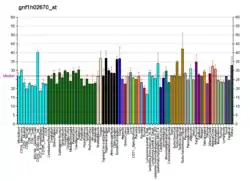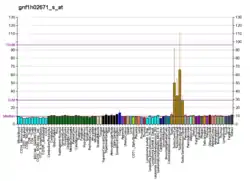SYCP3
Synaptonemal complex protein 3 is a protein that in humans is encoded by the SYCP3 gene.[5][6][7] It is a component of the synaptonemal complex formed between homologous chromosomes during the prophase of meiosis.[8]
Gene family
| ||||||||||||||||||||||
SYCP3 is also known as COR1. It contains a conserved coiled-coil domain that is also found in the FAM9 (FAM9A, FAM9B) family of proteins, found on the human X chromosome.[5]
Several SYCP3-like proteins are found on mice sex chromosomes. They are assigned names starting with Slx or Sly depending on the chromosome they are linked to. Slx/Slxl1 and Sly are neofunctionalized ones that have opposite effects on gene expression and epigenetic modifications, and each gene reduces the viability and mobility (via spindlin binding) of sperms containing the other sex chromosome, tilting the sex ratio to their own favor.[9] Over time they are duplicated to balance out each other's effects.[10]
References
- GRCh38: Ensembl release 89: ENSG00000139351 - Ensembl, May 2017
- GRCm38: Ensembl release 89: ENSMUSG00000020059 - Ensembl, May 2017
- "Human PubMed Reference:". National Center for Biotechnology Information, U.S. National Library of Medicine.
- "Mouse PubMed Reference:". National Center for Biotechnology Information, U.S. National Library of Medicine.
- Martinez-Garay I, Jablonka S, Sutajova M, Steuernagel P, Gal A, Kutsche K (September 2002). "A new gene family (FAM9) of low-copy repeats in Xp22.3 expressed exclusively in testis: implications for recombinations in this region". Genomics. 80 (3): 259–67. doi:10.1006/geno.2002.6834. PMID 12213195.
- Mallon AM, Platzer M, Bate R, Gloeckner G, Botcherby MR, Nordsiek G, et al. (June 2000). "Comparative genome sequence analysis of the Bpa/Str region in mouse and Man". Genome Research. 10 (6): 758–75. doi:10.1101/gr.10.6.758. PMC 310879. PMID 10854409.
- "Entrez Gene: SYCP3 synaptonemal complex protein 3".
- Syrjänen JL, Pellegrini L, Davies OR (June 2014). "A molecular model for the role of SYCP3 in meiotic chromosome organisation". eLife. 3. doi:10.7554/eLife.02963. PMC 4102245. PMID 24950965.
- Cocquet J, Ellis PJ, Mahadevaiah SK, Affara NA, Vaiman D, Burgoyne PS (September 2012). "A genetic basis for a postmeiotic X versus Y chromosome intragenomic conflict in the mouse". PLOS Genetics. 8 (9): e1002900. doi:10.1371/journal.pgen.1002900. PMC 3441658. PMID 23028340.
- Kruger AN, Brogley MA, Huizinga JL, Kidd JM, de Rooij DG, Hu YC, Mueller JL (October 2019). "A Neofunctionalized X-Linked Ampliconic Gene Family Is Essential for Male Fertility and Equal Sex Ratio in Mice". Current Biology. 29 (21): 3699–3706.e5. doi:10.1016/j.cub.2019.08.057. PMC 7012382. PMID 31630956.
Further reading
- Yuan L, Liu JG, Zhao J, Brundell E, Daneholt B, Höög C (January 2000). "The murine SCP3 gene is required for synaptonemal complex assembly, chromosome synapsis, and male fertility". Molecular Cell. 5 (1): 73–83. doi:10.1016/S1097-2765(00)80404-9. PMID 10678170.
- Suzuki H, Fukunishi Y, Kagawa I, Saito R, Oda H, Endo T, et al. (October 2001). "Protein-protein interaction panel using mouse full-length cDNAs". Genome Research. 11 (10): 1758–65. doi:10.1101/gr.180101. PMC 311163. PMID 11591653.
- Lee J, Iwai T, Yokota T, Yamashita M (July 2003). "Temporally and spatially selective loss of Rec8 protein from meiotic chromosomes during mammalian meiosis". Journal of Cell Science. 116 (Pt 13): 2781–90. doi:10.1242/jcs.00495. PMID 12759374.
- Miyamoto T, Hasuike S, Yogev L, Maduro MR, Ishikawa M, Westphal H, Lamb DJ (November 2003). "Azoospermia in patients heterozygous for a mutation in SYCP3". Lancet. 362 (9397): 1714–9. doi:10.1016/S0140-6736(03)14845-3. PMID 14643120. S2CID 44513816.
- de Boer P, Giele M, Lock MT, de Rooij DG, Giltay J, Hochstenbach R, te Velde ER (2004). "Kinetics of meiosis in azoospermic males: a joint histological and cytological approach". Cytogenetic and Genome Research. 105 (1): 36–46. doi:10.1159/000078007. hdl:1874/11543. PMID 15218256. S2CID 26325415.
- Stouffs K, Lissens W, Tournaye H, Van Steirteghem A, Liebaers I (October 2005). "SYCP3 mutations are uncommon in patients with azoospermia". Fertility and Sterility. 84 (4): 1019–20. doi:10.1016/j.fertnstert.2005.04.033. PMID 16213863.
- Aarabi M, Modarressi MH, Soltanghoraee H, Behjati R, Amirjannati N, Akhondi MM (August 2006). "Testicular expression of synaptonemal complex protein 3 (SYCP3) messenger ribonucleic acid in 110 patients with nonobstructive azoospermia". Fertility and Sterility. 86 (2): 325–31. doi:10.1016/j.fertnstert.2005.12.070. PMID 16824523.
- Sapkota G, Knockaert M, Alarcón C, Montalvo E, Brivanlou AH, Massagué J (December 2006). "Dephosphorylation of the linker regions of Smad1 and Smad2/3 by small C-terminal domain phosphatases has distinct outcomes for bone morphogenetic protein and transforming growth factor-beta pathways". The Journal of Biological Chemistry. 281 (52): 40412–9. doi:10.1074/jbc.M610172200. PMID 17085434.
- Martínez J, Bonache S, Carvajal A, Bassas L, Larriba S (October 2007). "Mutations of SYCP3 are rare in infertile Spanish men with meiotic arrest". Fertility and Sterility. 88 (4): 988–9. doi:10.1016/j.fertnstert.2006.11.163. PMID 17434513.





